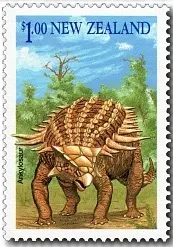The name 'dinosaur' originates from a combination of two Greek words: 'deinos' meaning terrible and 'sauros' meaning lizard. It is these 'terrible lizards' - in particular those that once walked on New Zealand soil - that are the subject of this stamp issue.
For 165 million years dinosaurs ruled the earth with unparalleled strength and power. To date, some 500 types of dinosaur have been identified, but this is believed to be only a fraction of the species that actually existed. They came in all shapes and sizes (some were as small as chickens, while some were as tall as five-storey buildings) and they displayed a wide range of social behaviour patterns (some were gentle in nature and ate plant life, while others were violent and threatening, and ate those that ate the plant life!).
The Stamps.
45c - Sauropod.
A giant herbivore that used its long giraffe-like neck to graze on lush treetop vegetation. Apatosaurus (also called brontosaurus) and diplodocus are among the best known of this group of dinosaur.
80c - Pterosaur.
The pterosaurs were the first animals (other than insects) to take to the air and fly. Their wings were large membranes of skin which measured four metres across. The pterosaurs diet consisted of fish and other marine life.
$1.00 - Ankylosaur.
Up to three metres long and weighing around half a tonne, the herbivorous ankylosaur was well protected from predators with a heavy bone armour which plated its back and head.
$1.20 - Mauisaurus.
Mauisaurus was a plesiosaur - a marine reptile that swum with its head above the water and fed on fish and other prey. Measuring nine metres long, mauisaurus was the largest plesiosaur to be found in New Zealand waters.
$1.50 - Carnosaur.
The large meat-eating carnosaur was among the most terrifying of all dinosaurs. It walked on its hind legs, had powerful clawed hands and may have been capable of speeds of up to 40 or 50 kilometres per hour!
Stamp Booklet.
45c - Carnosaur Attacking a Sauropod.
Booklet containing 10 x 45c gummed stamps.
Other Collector Items.
Miniature Sheet with one $1.50 stamp.
1993 Bangkok Stamp Exhibition.
1993 Bangkok Stamp Exhibition.
Between 1-10 October 1993 stamp collectors, postal administrations and exhibitors flocked to Thailand to attend Bangkok '93 World Philatelic Exhibition. New Zealand Post produced an overprinted 1993 Dinosaur miniature sheet to commemorate the event.
Dinosaur Exhibition Miniature Sheet.
Dinosaur Exhibition Miniature Sheet First Day Cover - 1 October 1993.
Technical information
Date of issue:
|
1 October 1993
|
|---|---|
Designer:
|
Geoffrey Cox, Auckland, NZ
|
Printer:
|
Southern Colour Print, Dunedin
|
Stamp size:
|
28mm x 40mm
|
Miniature sheet size:
|
124mm x 99mm
|
Sheet size:
|
100 stamps per sheet; 10 stamps per booklet; Miniature Sheets of one stamp
|
Process:
|
Lithography
|
Perforation gauge:
|
Sheet stamps: 13.5; Booklet stamps: 12; Miniature Sheet stamp: 14.5 x 14
|
Paper type:
|
Harrison and Sons, red phosphor coated, unwatermarked
|
Period of sale:
|
These stamps remained on sale until 1 October 1994.
|
Some of the images in this post were used with permission from the illustrated catalogue of StampsNZ
You can visit their website and Online Catalogue at, http://stampsnz.com/
Information for this post came from.













We appreciate your engagement with our content. To ensure a respectful and constructive community, please take note of the following:
- No Spam, Please: We do not tolerate spammy or promotional comments. Any such comments will be promptly removed.
- Moderation in Place: All comments are moderated to maintain a positive and inclusive environment. Please be patient, as it may take a little time for your comment to appear.
- Sign In with Google: To comment, please sign in using your Google account. This helps us maintain the integrity of our community and allows for better interaction.